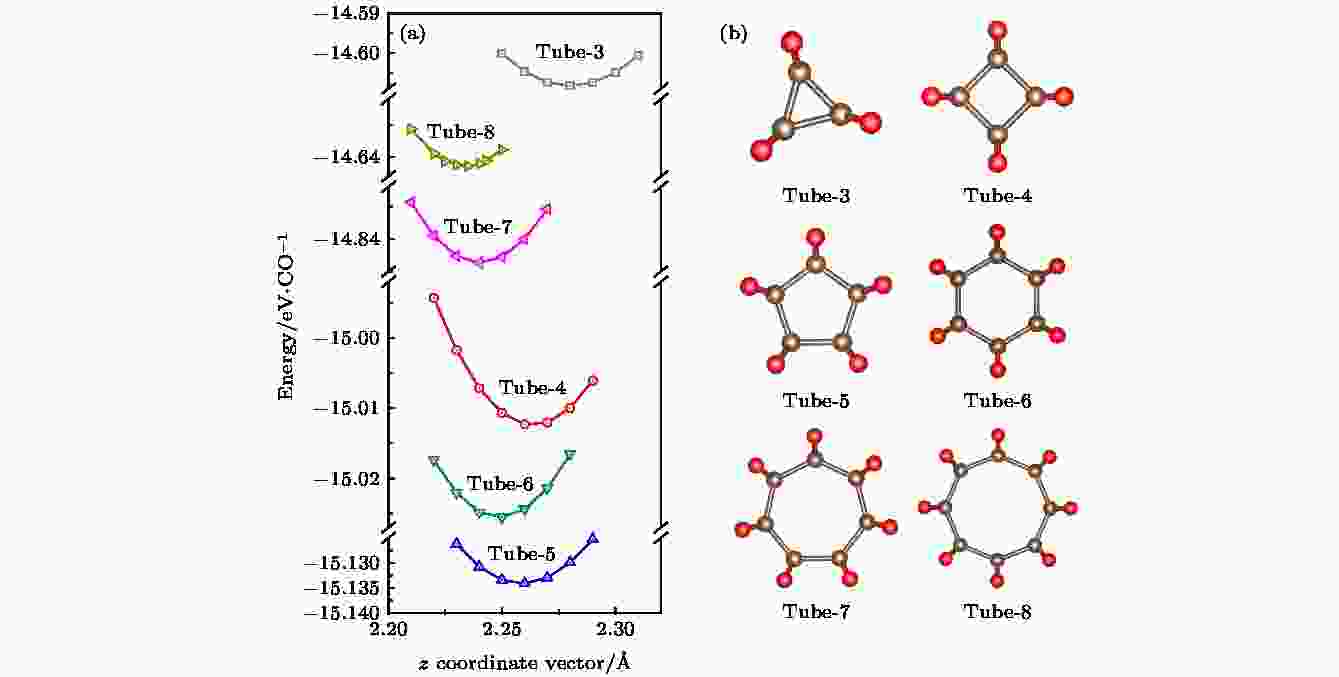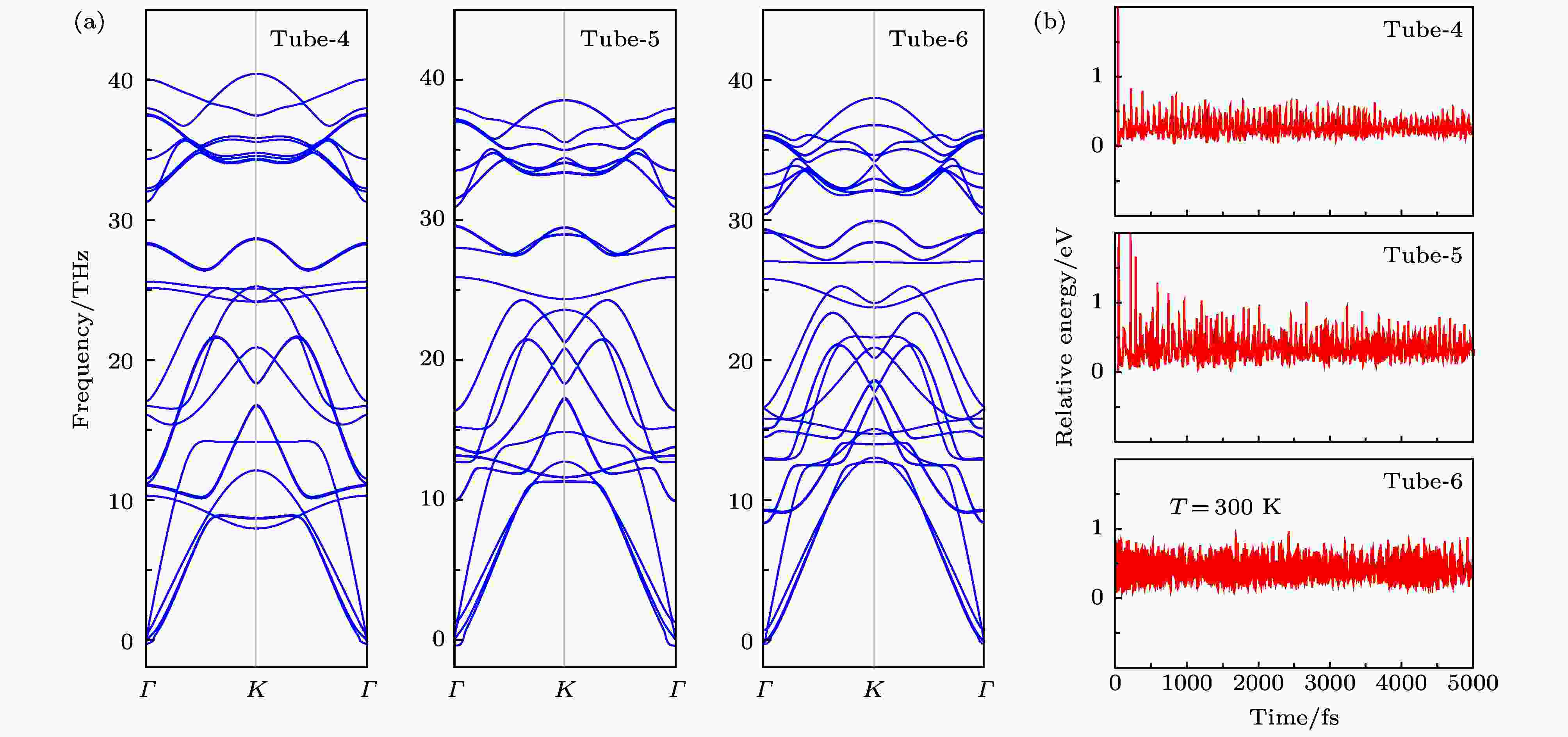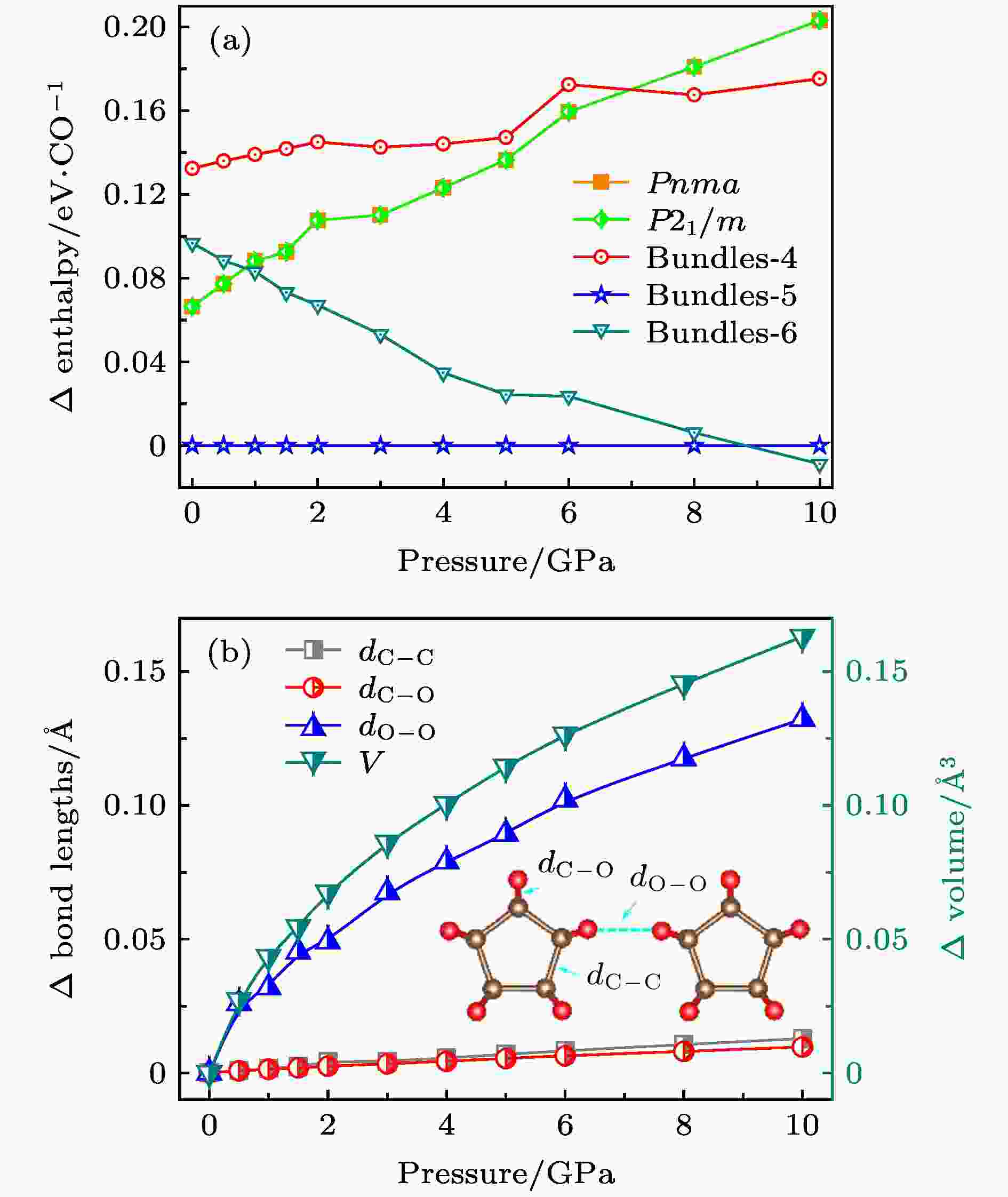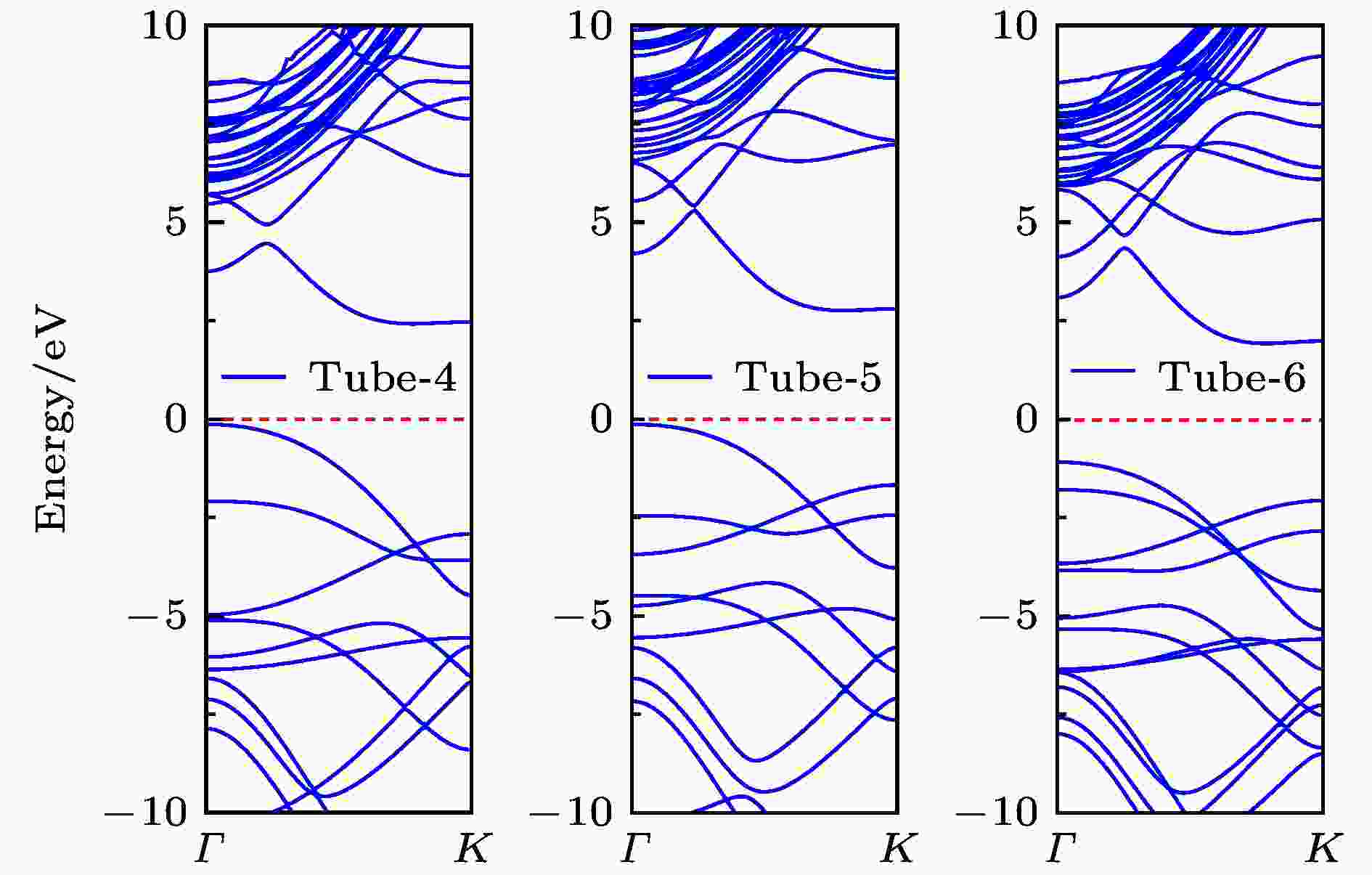全文HTML
--> --> -->早在20世纪70年代, CO的固态相变过程已经开始被人们研究. 例如低温低压下(4 GPa, 50 K左右), 气体就可以转化为ε相聚合物, 形成菱方晶格的CO固体, 此时如果温度升高到100 K时, ε相转化为δ相, 形成立方晶格的CO固体[25]. 当压强升到5 GPa, 共价键就会发生化学变化, 由CO转化为二氧化三碳(C3O2)和三氧化二碳(C2O3), 接着C3O2也会分离, 仅剩余二聚体—C2O3[26,27]. 但在1998年, 有实验组经过更加精确的红外分析法和拉曼分析法得出了相悖的结论—没有任何证据证明C3O2分子的存在, 同时也就不能推断出C2O3二聚体的存在[14]. 同年, 有研究表明CO在低压下更易形成五环状的CO高聚物 [15]. 随着科技的进步, CO晶体材料的研究得到了广泛的发展, 不断有新的发现被报道, 从0 GPa到80 GPa, 压强不断升高的过程中, CO气体发生了一系列变化, 由气体到高聚物、到分子晶体、到原子晶体, Sun等[16]给出了系统详细的分析. 研究显示, CO分子晶体结构要比CO高聚物更稳定, 链状的CO晶体结构要比分子晶体稳定. 当压强为0 GPa时, Pnma和P21/m空间群CO晶体结构要比α相的CO分子晶体在能量上低0.18 eV/CO, 而α相的CO分子晶体是由液态CO在低温大气压下结晶形成的[18], 在低压下, Pnma和P21/m空间群的CO晶体结构是目前研究中最稳定的结构状态.
在低压下, Sun等[16]认为, 通过共价键和范德瓦耳斯力形成的链状晶体结构是CO的最稳定结构. 纳米管束结构内部是共价键, 管与管之间是范德瓦耳斯力, Pnma和P21/m空间群的CO晶体结构也类似, 分子链内为共价键, 分子链之间为范德瓦耳斯力. 既然CO能够形成链状晶体, 那么CO能不能形成类似的管束状晶体呢? 以此推测, 本文设计了一种新型纳米管束状结构的CO晶体. 其内部由碳原子搭建成环状结构, 每个碳原子连接两个氧原子构成一个结构单元, 两个结构单元之间通过氧-氧共价键连接. 通过分析显示, CO纳米管束结构中, 内部为碳五环时(Bundles-5), 在能量上最稳定. 在Bundles-5中, 每个碳原子均为sp3 杂化, 且碳原子与碳原子的夹角约为109.5°, 接近于金刚石的杂化方式, 因此Bundles-5在所有管束状结构中最稳定. 计算分析表明, 低压下Bundles-5晶体结构的能量比空间群为Pnma和P21/m的CO链状晶体结构更低. 通过分析电子结构性质得知, 管束状晶体结构是宽带隙半导体, 而链状CO晶体是金属性质, 因为密度泛函理论会低估带隙的宽度, 本文中用杂化泛函(HSE)理论对五环纳米管的带隙进行了校正, 约为4.44 eV. 新型纳米管束状结构的CO晶体, 填补了CO晶体结构中无管束状结构的空白, 同时也打破了低压下CO晶体结构仅为金属性质的结论, 这为研究低压下CO的晶体结构提供了新的方向.
3.1.纳米管结构的设计以及稳定性分析
根据碳原子与氧原子的成键方式, 本文中搭建了六种不同的CO纳米管. 因为碳原子最外层有四个价电子, 可以形成四条共价键, 氧原子最外层有六个价电子, 可以形成两条共价键, 因此纳米管的内部均由碳原子构成, 形成碳环, 由3—8个碳原子组成, 每个碳原子除构成碳环的两条共价键, 还有连接氧原子的一条碳-氧共价键, 如图1(a)的内插图所示, 氧原子作为桥梁连接两个不同的碳环, 按照这个规律就构成内部由碳原子构成碳环, 通过氧原子连接碳环在z方向上形成无限长的CO纳米管结构. 根据Bader电荷分析可知, 无论是何种纳米管, 每个原胞中, 碳原子最外层的电子密度是相同的, 即碳原子是等价的, 同样氧原子最外层的电子密度也是相同的, 即原胞中每个氧原子也是等价的, 每个原胞中, 每个碳原子向与其连接的氧原子转移0.95—0.99个电子, 如表1所列, 两者形成共价键. 在图1(a)中每个氧原子连接两个碳原子, 原胞中一个碳原子, 隔壁原胞中一个碳原子, 每个碳原子为氧原子提供一个电子形成共价键, 恰好与Bader分析相对应. 按照内环碳原子的个数, 这些纳米管被命名为Tube-3, Tube-4, Tube-5, Tube-6, Tube-7, Tube-8, 图2(b)即为Tube-3— Tube-8的横截面图. 图 1 (a)每种CO纳米管的相对能量; (b)每种CO纳米管键角相对于直径的函数图像
图 1 (a)每种CO纳米管的相对能量; (b)每种CO纳米管键角相对于直径的函数图像Figure1. (a) Relative energy of each CO nanotube; (b) the bond angle as a function of the diameter of each CO nanotube
| dC—C/? | dC—O/? | Etol/eV·CO–1 | Ecoh/eV·CO–1 | CCHG—OCHG/e | |
| Tube-3 | 1.53 | 1.40 | –14.61 | 0.16 | 0.99 |
| Tube-4 | 1.58 | 1.40 | –15.01 | –0.24 | 0.99 |
| Tube-5 | 1.58 | 1.41 | –15.13 | –0.36 | 0.98 |
| Tube-6 | 1.61 | 1.41 | –15.03 | –0.25 | 0.95 |
| Tube-7 | 1.64 | 1.40 | –14.84 | –0.07 | 0.96 |
| Tube-8 | 1.67 | 1.40 | –14.64 | 0.13 | 0.93 |
表1CO纳米管的键长dC—C和dC—O, 每个CO单元的总能量Etol和形成能Ecoh, 以及纳米管每个原胞中碳原子转移给氧原子的电荷数CCHG—OCHG
Table1.Structural parameters of Tube-3?Tube-7, where dC—C is bond length between carbon atoms, dC—O is bond length between carbon atom and oxygen atom; total energy (Etol) and cohesive energy (Ecoh); electron transfer from carbon atom to oxygen atom (CCHG—OCHG)
 图 2 各纳米管z方向晶格扫描能量图(a)和横截面图(b)
图 2 各纳米管z方向晶格扫描能量图(a)和横截面图(b)Figure2. Lattice scanning energy diagrams (a) and cross sections (b) of various nanotubes according z direction
每种纳米管的重复单元(即原胞)的碳原子个数是不一样的, 碳环的直径也是不一样的, 也就意味着环与环之间的桥梁, 即氧原子的相对位置也是有区别的, 为了解决这些问题, 沿着周期性方向上的晶格扫描过程是必不可少的. 按照纳米管设计的原则, z方向为纳米管的周期性方向, 所以在此方向晶格基矢是放开的, 在x方向和y方向晶格基矢均为固定值, 20 ?的真空层, 以隔绝纳米管之间的相互作用. 当然原胞中的原子坐标是放开的. 通过晶格扫描, 以纳米管在z方向上的晶格基矢长度为横坐标, 以能量为纵坐标, 做出不同纳米管随着z方向上晶格基矢长度变化的能量分析图, 如图2(a)所示. 通过图像可知, 构成纳米管内部碳环的碳原子数越少即碳环直径越细, 环与环之间的距离越远, 当然, 从能量上比较碳五环结构的纳米管能量最低, 即五环纳米管结构(Tube-5)是最稳定的纳米管结构, 这与之前的研究有一定的相符性, CO气体在低压下容易形成五边形结构[15]. 由图2的能量分析图还可以看出, 碳四环和六环的CO纳米管(Tube-4和Tube-6)能量相对较低, 结构较稳定, 而碳三环、七环和八环的纳米管结构(Tube-3, Tube-7 和Tube-8)能量较高. 根据形成能的计算公式Ecoh = Etol – Egas, 其中Etol为体系平均到每个CO单位上的总能量, Egas为气态CO分子的总能量, 所得到的形成能平均到每个CO单位上为Ecoh, 所得结果如表1所列, Tube-3和Tube-8的形成能大于零, 虽然Tube-7的数值小于零, 但是能量较高, 而Tube-4, Tube-5和Tube-6纳米管的形成能比较低, 相对更稳定. 基于以上能量分析, 在接下来的研究过程中, 本文仅对在能量上较稳定的Tube-4, Tube-5 和Tube-6进行对比讨论, 而Tube-3, Tube-7 和Tube-8纳米管不再讨论.
通过晶格基矢的扫描得知, Tube-5纳米管碳环与碳环之间的距离是2.26 ?, 即z方向上的基矢即为2.26 ?. 以碳环的碳原子个数为横坐标, 以每种纳米管最稳定能量相对于Tube-5纳米管的相对能量为纵坐标, 即Tube-5纳米管的能量为零, 做出相对能量与碳环碳原子个数的曲线图(图1(a)). 通过图像可知, Tube-5纳米管能量最低, 即最稳定.
那么Tube-5 CO纳米管最稳定的原因是什么呢? 图1(a) 中, 以Tube-5的结构为例, 三个碳原子构成的正N边形的内角, 即碳-碳-碳角(∠1–∠CCC), 每个碳原子与桥梁氧原子以及相邻碳原子构成外角, 即氧-碳-碳角(∠2–∠OCC). 内角和外角随CO纳米管直径的变化规律如图1(b)所示. 通过分析六种CO纳米管中碳原子的两种键角, 得到以下结论: 随着直径的变大, 内角越来越大, 外角越来越小. 而Tube-5纳米管的内角和外角分别为108.0° 和110.5°, 恰好与金刚石的键角(109.5°)最为相近. 因此Tube-5 CO纳米管中碳原子的杂化方式, 最接近于金刚石中的碳原子, 即sp3 杂化, 而其他纳米管的碳原子杂化方式是不完全的sp3 杂化. 碳位于第四主族, 具有三种截然不同的杂化方式: sp, sp2, sp3. 自然界中目前发现的天然碳单质为石墨(sp2杂化)、金刚石(sp3杂化)和无定形碳. 由图1(b)分析可知, Tube-5纳米管的杂化方式与金刚石最接近, 这可以解释为什么Tube-5纳米管最稳定. 与此同时, 对于不同纳米管的键长我们也进行了定量的分析, 如表1所列, 在不同的纳米管中, 碳-氧键的键长处于1.40—1.41 ?之间, 并不受CO纳米管直径变化的影响, 而碳-碳键的键长随着纳米管直径的增大而增大, 在相同的计算参数下, 金刚石碳-碳键长为1.55 ?, 其数值介于Tube-3—Tube-5键长之间. 当然验证新型材料是否稳定的方式有很多种, 能量上是否收敛仅仅是一个方面. 目前, 用声子谱是否有虚频也是验证能量稳定性的方式之一, 为此, 本文通过PHONOPY软件包计算分析了Tube-4, Tube-5 和Tube-6三种纳米管的声子谱, 如图3(a)所示, 这三种纳米管均没有虚频, 再一次验证了Tube-4, Tube-5 和Tube-6三种CO纳米管在能量上的稳定性. 为证明纳米管的热力学稳定性, 在室温下(T = 300 K), 每种纳米管以1 fs的速度振动5000步, 纳米管材料的结构保持不变, 而且能量趋近于稳定值, 如图3(b)所示, 虽然模拟时间很短, 但也在一定程度上验证了纳米管材料的热力学稳定性.
 图 3 (a) Tube-4—Tube-6的声子谱; (b)分子动力学模拟图像
图 3 (a) Tube-4—Tube-6的声子谱; (b)分子动力学模拟图像Figure3. (a) Phonon spectra and (b) evolution of energy as a function of time during the molecular dynamics simulations at 300 K of Tube-4? Tube-6
2
3.2.CO纳米管束的稳定性分析和电子结构性质预测
最新研究表明, 通过范德瓦耳斯力堆垛而成的CO纳米链的晶体结构, 比CO分子晶体结构更稳定, 其空间群为Pnma和P21/m, 并且在低压下, 链状晶体结构是目前发现的最稳定结构[16]. 而我们提出的CO纳米管也可以通过范德瓦耳斯力堆垛形成三维晶体结构, 类似于碳纳米管束状结构. 表2列出了三种纳米管按照不同的密堆积方式计算得出的总能量, 通过计算分析能量的稳定性, 三种较稳定的CO纳米管堆垛方式如图4所示, 将CO纳米管束状晶体结构分别命名为Bundles-4, Bundles-5和Bundles-6. Bundles-4纳米管束状晶体是正方格子, 而Bundles-5和Bundles-6通过六角密堆积方式构建而成. 纳米管内是共价键相互作用, 而纳米管之间是范德瓦耳斯力相互作用, 这与碳纳米管束是完全一致的.| Bundles-4 | Bundles-5 | Bundles-6 | |
| Square | –15.149 | –15.268 | –15.159 |
| Hexagon | –15.146 | –15.276 | –15.161 |
表2CO纳米管束不同密堆积方式的总能量 (单位: eV/CO)
Table2.Total energy of different dense packing modes of nanometer tube bundles (in eV/CO)
 图 4 Tube-4—Tube-6纳米管堆垛而成的纳米管束结构
图 4 Tube-4—Tube-6纳米管堆垛而成的纳米管束结构Figure4. Structure diagram of nanotube bundle
之前的研究显示链状晶体结构在低压下是最稳定的结构, 比CO分子晶体还要稳定, 而这两种链状结构和纳米管束状结构的共同点在于: 均有单条纳米带或者纳米管通过范德瓦耳斯力堆垛形成晶体, 内部主要是共价键的作用, 链与链、管与管之间是范德瓦耳斯力的相互作用. 为此, 我们将CO纳米管束状晶体结构和Pnma和P21/m这两种链状结构进行分析对比, 图5(a)给出了这三种结构随着压强增大焓值的变化量. 其中焓值是通过公式 H = U + PV计算所得, U为0 K下结构的内能值, P为晶体结构外部环境的静水压强, V为每个CO单元的体积. 通过图5(a)的对比分析可知, 在10 GPa以下的低压下, Bundles-5 纳米管束状晶体结构比Pnma和P21/m两种链状晶体结构更稳定. 在非常小的压强下, 如1 GPa以下, Bundles-4 和Bundles-6 纳米管束状晶体结构不如Pnma和P21/m两种晶体结构稳定. 但随着压强的增大, 管束状结构的晶体结构变得更稳定, 特别是Bundles-6 纳米管束晶体, 当压强大于1 GPa时, 它的稳定性就大于P21/m和Pnma两种链状晶体. 在压强大于8.6 GPa时, 其稳定性就超越了Bundles-5纳米管束状结构. 因此通过焓值的变化可以判定, 在低压下CO纳米管束状结构更稳定.
 图 5 (a)五种不同一氧化碳晶体的焓变函数; (b) Bundles-5带隙和结构参数随压强的变化
图 5 (a)五种不同一氧化碳晶体的焓变函数; (b) Bundles-5带隙和结构参数随压强的变化Figure5. (a) Enthalpy function of five different kinds of carbon monoxide crystals; (b) band gap and structural parameters vary with pressure of Bundles-5
晶体的电子结构性质受共价键的影响比较大, 受分子间相互作用力的影响较小. 如图5(b) 所示, 本文以Bundles-5 CO纳米管结构为例, 研究CO纳米管的晶体结构参数随压强的变化. 在图5(b)中, 纳米管结构的共价键对于压强的变化并不敏感, 无论是碳-碳共价键还是碳-氧共价键在压强增加时, 其变化非常小, 但是纳米管间的距离对于压强来说是十分敏感的, 压强越大, 管间距越近, 也就意味着晶格体积越小. 虽然随着压强的增加, 共价键变化很小, 分子之间的相互作用力, 即范德瓦耳斯力变化还是很大的. 但众所周知, 范德瓦耳斯力对于材料的电子结构性质的影响是有限的, 可以忽略, 所以文中用纳米管Tube-4, Tube-5, Tube-6的电子结构性质来预测纳米管束Bundles-4, Bundles-5, Bundles-6的电子结构性质. 如图6所示, 通过分析Tube-4—Tube-6 CO纳米管能带结构图可知, CO纳米管结构均为非直接带隙的半导体, 相应的带隙大小分别为 2.60, 2.93和 3.07 eV. 由于PBE泛函的交换关联算法一般都会低估材料的带隙, 因此本文采用杂化关联泛函(HSE06)的方式校正了纳米管结构的带隙, 校正后, Tube-5 CO纳米管结构的带隙为4.44 eV, 但能带随高对称性点的变化趋势是一样的. 由此可以推断出, CO的纳米管束状晶体结构应该是宽带隙的半导体. 相对于Pnma和P21/m两种链状晶体的金属性质, CO纳米管束状晶体的电子结构与链状晶体截然不同, CO纳米管束状结构为半导体性质. 因此可知低压下, CO的固态相既可以是金属, 也可以是半导体.
 图 6 Tube-4—Tube-6的能带结构
图 6 Tube-4—Tube-6的能带结构Figure6. Band gap of Tube-4?Tube-6
感谢山东大学物理学院赵明文教授、山东建筑大学杨博博士以及河南农业大学刘小标老师的讨论.
